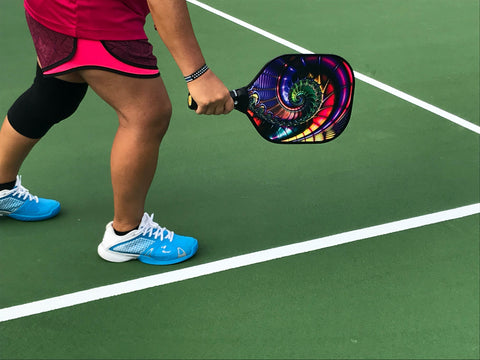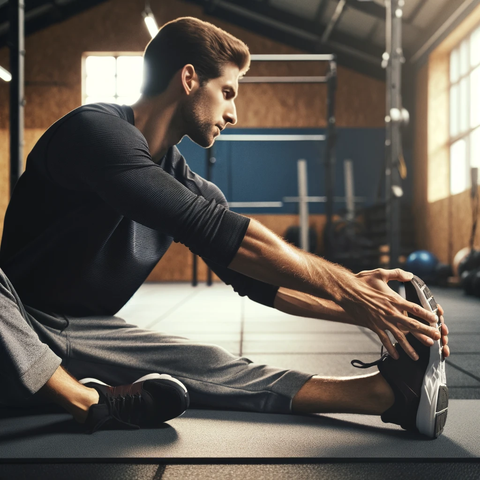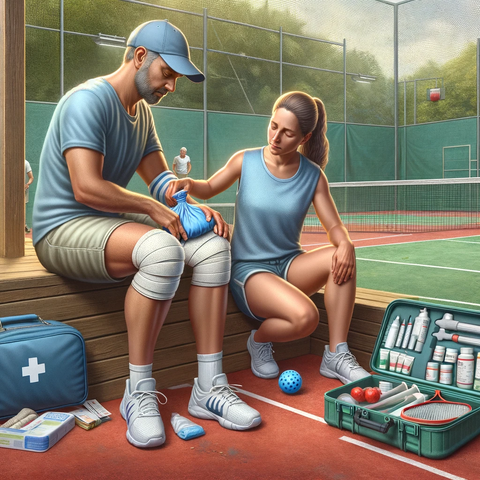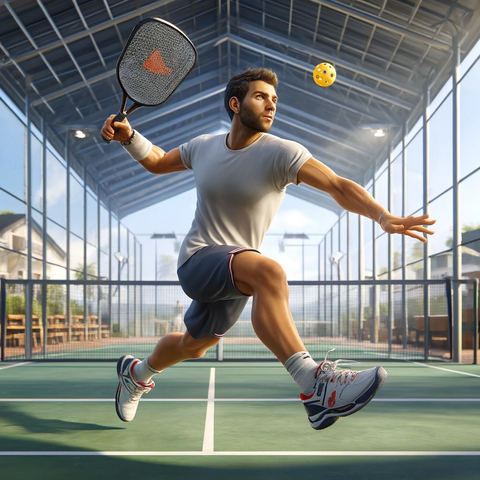Contents (Jump to a section)
How to Avoid Injury in Pickleball: Injury Prevention Advice and Stats

Are you one of the many millions of people who have recently discovered the joy of pickleball? The sport has surged in popularity in the last few years, captivating players of all ages with its unique blend of tennis, badminton, and ping pong.
Unfortunately, as with any physical activity, there's always a potential for an injury that can leave you watching from the sidelines in frustration, or with a long recovery period ahead of you. So, what can you do for pickleball injury prevention?
In this article, we’ll discuss how to avoid injury in pickleball. With the right knowledge and precautions, you can minimize your chances of picking up an injury and focus on enjoying the game ahead of you.
We’ll also share some pickleball injury statistics and uncover the most common injuries in pickleball - the results might surprise you!
The Significance of Pickleball Injury Prevention
In pickleball, swift movements, precise shots, and lightning-quick reflexes are the key to success on the court. While the sport offers an exciting way to stay active and connect with others, it also carries inherent risks that can lead to physical setbacks.
Before we discuss how to avoid injury in pickleball, let’s first take a look at why pickleball injury prevention is so important in the first place.
The Mental Toll of Being Sidelined
An injury doesn't only affect the body; it takes a toll on the mind as well. For those who have developed a passion for pickleball, being sidelined due to an injury can lead to feelings of frustration, disappointment, and even a sense of loss.
The camaraderie of the court and the joy of playing can be sorely missed, potentially leading to a decline in mental well-being. The mental challenge of staying motivated during recovery can often be as demanding as the physical rehabilitation itself.
How Pickleball Injury Affects Your Normal Life
An injury acquired during a pickleball game can reverberate through various aspects of your daily life. Simple tasks that were once taken for granted may suddenly become difficult, slow, painful, or even impossible, disrupting your regular routines and independence.
Whether it's struggling with mobility, requiring assistance for everyday activities, or having to adapt to a new routine, an injury can reshape your normal life in unexpected ways.
By prioritizing pickleball injury prevention, you not only preserve your participation in the sport but also safeguard your overall quality of life.
The Financial Costs of Injuries From Pickleball
Injuries often come with unforeseen financial burdens, which can compound the challenges of recovery. Medical bills, rehabilitation costs, and potential time away from work can all contribute to a strain on your finances.
These expenses can accumulate quickly, leading to unnecessary stress and affecting the way you live. By learning how to avoid injury in pickleball, you can protect your physical well-being and prevent the potential financial strain that arises from medical bills.
Pickleball Injury Statistics
What is the most common injury in pickleball? Is the pickleball injury rate high? Let’s take a look at some common pickleball injury statistics to help you understand what the risks of this fun, fast-paced sport are.
Most Popular Pickleball Injuries

Pickleball, blending elements of tennis, badminton, and table tennis, has quickly become a beloved pastime. Yet, it brings its own set of risks, primarily due to the quick movements and sharp turns the game demands.
Below, we outline the most common injuries encountered by pickleball enthusiasts. This summary, informed by healthcare experts, aims to highlight potential hazards, encouraging players to engage with the game more safely and reduce injury risks.
|
Rank |
Injury |
|
1 |
Sprained Ankle |
|
2 |
Tennis Elbow (Epicondylitis) |
|
3 |
Rotator Cuff Strain |
|
4 |
Hamstring Strain |
|
5 |
Groin Pull |
|
6 |
Knee Ligament Sprain |
|
7 |
Stress Fractures |
|
8 |
Achilles Tendonitis |
|
9 |
Lumbar Strain |
|
10 |
Wrist Tendonitis |
Are There a Lot of Injuries From Pickleball?
Pickleball, like any physical activity, carries the risk of injuries. While it is generally considered a low-impact sport, the combination of rapid lateral movements, sudden stops, and overhead shots can lead to various types of injuries.
According to data compiled from emergency room visits and injury reports, pickleball results in an average of around 19,000 injuries per year. Most of these affect individuals aged over 50, potentially due to the relationship between flexibility and aging.
What is the Most Common Injury in Pickleball?
So, what is the most common injury in pickleball? Of the pickleball injuries reported, sprains and strains are some of the most prevalent. Ankles, knees, and wrists are particularly susceptible to these types of injuries due to the abrupt directional changes and quick pivots involved in the game.
Shoulder injuries are also common, as are fractures. Understanding which areas of the body are more prone to injury can help you focus on targeted preventive measures, such as strengthening exercises and careful attention to movement mechanics.
Other Pickleball Injury Statistics
In terms of other pickleball injury statistics, what do you need to know? Around 60% of pickleball injuries are sprains, strains, and fractures, while 20% are contusions, abrasions, or internal injuries. It’s also estimated that pickleball injuries may cost Americans nearly $400 million each year.
How to Avoid Injury in Pickleball

Given the mental and physical toll that an injury takes, not to mention the financial cost that may come with it, learning how to avoid injury in pickleball is essential. So, what steps can you take for pickleball injury prevention? Let’s take a look.
Pre-Game Preparation: The Importance of a Dynamic Warm-Up
Never underestimate the power of a dynamic warm-up before stepping onto the court. Light cardio, joint mobility exercises, and dynamic stretching for injury prevention help increase blood flow, raise body temperature, and ready your muscles for the demands of pickleball.
A warm-up primes your body for action, enhancing its ability to move efficiently and reducing the risk of sudden strains. Make sure you warm up for 5-10 minutes before you play, and try to focus on exercises and movements that cover a variety of muscle groups.
Stretching Before and After Pickleball to Prevent Injury

Both static and dynamic stretching have their place in injury prevention. Prior to playing, focus on stretching your shoulders, hamstrings, and calves. Try doing some ankle mobility exercises to reduce your chances of a sprain or strain, and add stretches for shin splints as a preventative measure.
After the game, when your muscles are warm, static stretches help maintain flexibility and prevent tightness. Start by learning how to get better hip mobility, how to release tight calves, how to fix tight hamstrings, and how to stretch glutes and hamstrings.
You can make your stretches even more effective with the CastleFlexx. Specifically designed to relieve tension across your body, the CastleFlexx is among the best stretching equipment for pickleball injury prevention and many more assisted stretching benefits.
Strength and Conditioning Movements to Decrease Injury Risk
Incorporating strength and conditioning exercises into your routine can significantly bolster your injury resilience. Target areas like your core, legs, and upper body to enhance stability, balance, and muscular support.
Lunges, squats, planks, and resistance band exercises can all contribute to a stronger body and play an important role in pickleball injury prevention.
Gameplay Techniques for Safety
Our next piece of advice to avoid pickleball injury relates to how you actually play the game itself, as your pickleball techniques play a pivotal role in injury prevention. Master proper footwork and balance to reduce the strain on your joints.
At the same time, focus on maintaining good posture, as this can help prevent back and shoulder issues. And finally, practice controlled shots and movement to avoid overexertion and minimize the risk of sudden impacts.
Recovery and Rest Days
If you don’t want to add to the pickleball injury rate, make sure you give your body plenty of time to rest and recover. Incorporate rest days into your pickleball schedule to give your muscles and joints the chance to heal and rejuvenate.
Adequate sleep, hydration, and a balanced diet further contribute to your body's recovery process, ensuring you're ready for every game. Aim for 8 hours of sleep a night, and include lean proteins in your diet, as well as whole-grain carbs, plus plenty of fresh fruit and vegetables.
Gear Up Properly
Our final piece of advice to avoid pickleball injury: invest in the right gear! Appropriate gear can significantly impact your safety on the pickleball court.
Get some quality athletic shoes with proper cushioning and support to reduce your risk of ankle and foot injuries. Consider wearing protective gear like knee and elbow pads, particularly if you have a history of joint issues.
Advice on Managing Pickleball Injury

Even if you follow all the advice to avoid pickleball injury, there’s still a chance that you’ll be unlucky and pick up an injury at some stage. If that happens, here’s some advice to help your recovery go as smoothly and comfortably as possible.
First Steps After Injury
When an injury occurs, your immediate response sets the stage for your recovery. RICE, an acronym for Rest, Ice, Compression, and Elevation, serves as a valuable guideline in the initial stages.
Rest the injured area to prevent further strain, apply ice to reduce inflammation, use compression to manage swelling, and elevate the injured part to minimize blood flow and edema.
Consulting a Professional
While minor injuries might respond well to self-care, it's essential to consult a medical professional for a proper diagnosis and treatment plan. A doctor or a sports therapist can assess your injury, recommend appropriate interventions, and provide you with a roadmap for recovery.
Active Recovery and Rehabilitation
As your injury progresses, active recovery and rehabilitation become pivotal. Engage in exercises that target the injured area while being mindful of your limitations. A physical therapist can guide you through a range of motion exercises, strengthening routines, and flexibility work.
These exercises can aid in healing and prevent loss of function. Whether you’re recovering from tight calves and knee pain, tight glutes and back pain, or just about any other injury, stay patient and trust the process - you’ll be back on your feet before you know it.
Monitoring Your Progress and When to Return to Gameplay
Throughout your recovery journey, monitor your progress closely. Track improvements in pain, range of motion, and strength to gauge your readiness for a gradual return to pickleball.
Remember that rushing back into gameplay too soon can exacerbate the injury or lead to compensatory movements that might cause further issues. Talk to your healthcare provider or physical therapist to determine the optimal timing for your comeback.
Parting Thoughts on How to Avoid Injury in Pickleball

Although the pickleball injury rate might be higher than you originally expected, there are plenty of things you can do to reduce your chances of picking up an injury while enjoying this exciting new sport.
The most effective way of reducing your pickleball injury risk is by stretching properly, both before and after you play. Stretching prepares your muscles for activity, reduces your risk of injury, and helps you recover more effectively from each match.
With stretching equipment like the revolutionary CastleFlexx, you can get the most out of every stretch and relieve tension across your whole body. The CastleFlexx isn’t just ideal for pickleball injury prevention, it can deliver a whole host of other health and wellness benefits.
You can use the CastleFlexx to learn how to increase back flexibility, discover the benefits of fascial stretch therapy at home, reduce your Achilles recovery time, and speed up shin splint recovery. You can even find fun stretches for kids with the CastleFlexx!
Reduce your risk of a pickleball injury, and the mental, physical, and financial tolls that come with it. Stay safe on the court with CastleFlexx!
